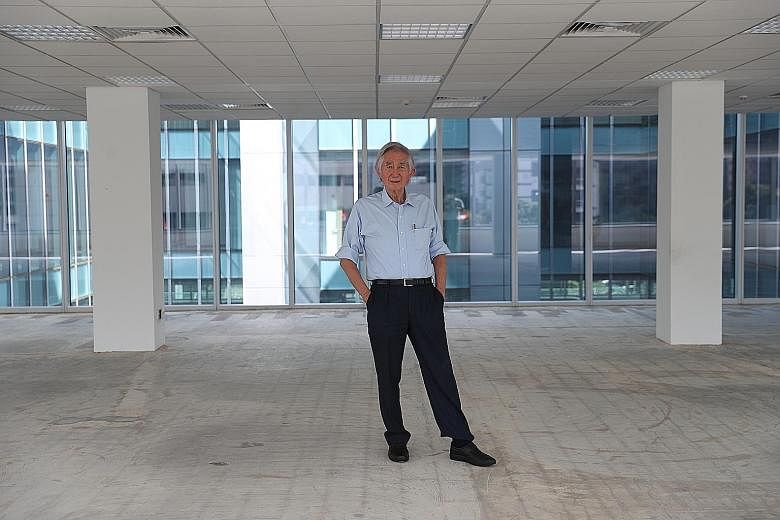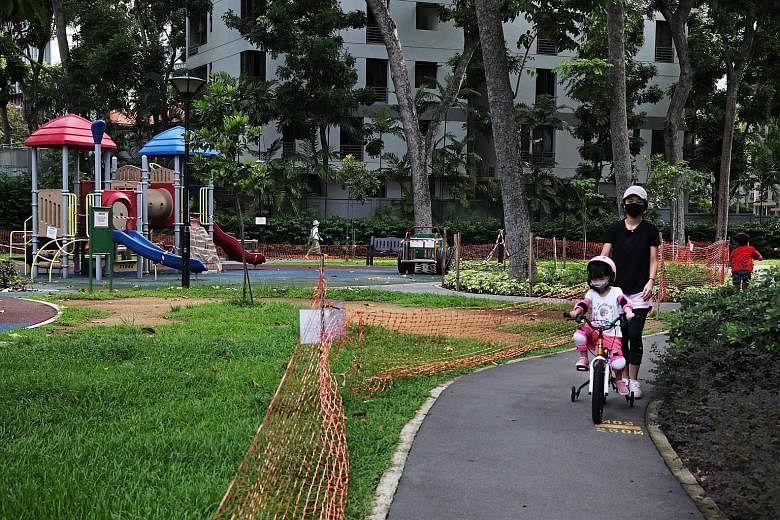Growing up as a young boy in Singapore in the 1940s, Mr Liu Thai Ker wondered why British colonial officials lived in such different housing from the locals.
"The buildings they occupied were very beautiful," he says. "But the areas for the locals were dilapidated and unpainted."
Three in four Singaporeans lived in squatter housing - unplanned settlements patched together from scraps of wood, tin and attap. As there was no running water in homes - people used pails to collect water from standpipes.
But there were simple pleasures to be found - the song of thousands of sparrows every evening, as they gathered on a tangle of overhead telephone wires; and the rhythmic "kling, kling, kling" of electric trams as they rattled through the streets.
The scenes from his childhood are a far cry from the gleaming Singapore skyline today. The man, known as the architect of modern Singapore, now runs his own firm in the prime Orchard Road area.
He founded Morrow Architects and Planners in 2017, after spending more than two decades in government service overseeing the modernisation of Singapore.
Its name is a homage to his father, pioneer painter Liu Kang, who set up a small sign-painting business, called Morrow Studio, during the Japanese Occupation in Singapore. The shop disguised the elder Liu's educated background, protecting him from being targeted as a resistance fighter by the Japanese.
FORGING A SINGAPORE IDENTITY
Born in 1938 in Muar, Johor, as the oldest of five children, Mr Liu originally wanted to be an artist like his father. Due to his mother's objections, he studied architecture instead.
After obtaining his master's in city planning from Yale University in 1965, and spending some time in renowned institutions, such as with architect I.M. Pei in New York, he returned to Singapore to lead the Housing Board's (HDB) design and research section.
He came up with a prototype for new towns, the self-sufficient neighbourhood estates that Singapore is known for today.
As chief planner of the Urban Redevelopment Authority (URA) in the 1990s, he contributed to revisions to the Concept Plan - a plan that arose from the British masterplan for Singapore - and had a key hand in conservation projects.
He admits that he "couldn't have done a damned thing" as a civil servant, had it not been for the courage and vision of Singapore's pioneer leaders, such as founding prime minister Lee Kuan Yew.
"If they did not have public housing policies, I could not have built HDB flats. If they did not have the Land Acquisition Act, I could not have got land from the private sector or squatters to build those flats."
The beauty of public housing here, he says, is that it consists of a single policy. "In many cities, they have several policies: one for the poorest, and one for the middle-income group. This has created a permanent segregation of income groups."
An innovation, he says, was the use of Central Provident Fund savings to buy flats. "If you own a flat, you become a shareholder of the country. So you want to take better care of your flat and your environment."
The mixing of different ethnic groups in HDB estates also meant that the Chinese, Malays and Indians over time saw themselves as Singaporean. "So the fact that we have this Singaporean identity did not come by pure luck, but through a lot of hard work."
IMPACT OF COVID-19
The URA has said that with more people working from home due to Covid-19, there will be changes to their commuting, retail consumption and lifestyle patterns.
Will Covid-19 lead to a decentralisation of work and social activities away from the city centre, I ask.
Mr Liu does not think the changes will be drastic, pointing out that cities have existed for thousands of years to meet the human need for social interaction. He says that even if retail shops are reduced in number and size, people will still want to go out and socialise.
He also notes that HDB flats have corridors that face outwards, as well as good ventilation and exposure to sunlight - features that, coincidentally, help minimise infection transmission.
The URA has said that the Central Business District (CBD) could have a larger residential population and more mixed uses. The CBD Incentive Scheme announced last year will incentivise the development of older parts of the district into residences, hotels and creative lifestyle areas.
Mr Liu, however, would prefer to see fewer residences in the CBD. "Some planners say, 'Oh, you need to allow people to live in the city to give it life'. But you're lucky if you can fit 50,000 residents inside.
"Do you want the life of the CBD to depend on 50,000 or 5.7 million people (Singapore's population)? The trick is to plan the CBD in such a way that it's so attractive, everyone from Singapore will come."
THAT 10 MILLION QUESTION
Recently, he found himself thrust under the spotlight for suggesting that Singapore should plan for 10 million people to remain sustainable.
During the general election, the Singapore Democratic Party claimed that this figure was taken from a Straits Times report on remarks made by Deputy Prime Minister Heng Swee Keat at a dialogue last year.
Mr Heng had cited Mr Liu in his response to a question on the Government's 2013 Population White Paper, but did not himself mention the 10 million figure.
Why this number, though?
Mr Liu says it is not a target but a worst-case scenario. Using the analogy of a bank account which has $10 million in contingency funds, he says it is a "blessing" if one does not use every single cent.
Stressing that the number is his personal opinion, he says he has not had "any serious professional exchange" with government officials since he left public service more than 20 years ago.
He works out the maths for me - in 1960, there were around 1.6 million people in Singapore; now, 60 years on, there are 5.7 million.
"Let's say next year, we have 5.8 million. The increase since 1960 is 4.2 million. If you add this to 5.8 million, you get 10 million."
If the population increases at the same rate, the existing planning parameters will last only another 60 years. If it increases at half the rate, the parameters can only apply for 120 years, and so on, he says.
"So if we have 10 million people, and we don't start marking out those additional expressways and MRT lines now, where will we find the land when we need it? There will be serious traffic problems."
He poses an existential question: How long do Singaporeans want the country to last as a sovereign state?
"Don't we want our children and grandchildren to stay here for the next few hundred, thousand years? So, if anything at all, (planning for 10 million) is not excessive."
This is also why HDB flats come with 99-year leases, he says. If there are more people than Singapore's land can support, the Government can take back buildings, pull them down, and rebuild to a higher density.
What about Singaporeans who fear that the value of their flats will decrease to zero when the lease runs out?
"I think citizens must respect that at the end of 99 years, the flat goes back to the Government - because that's clearly spelt out in the lease terms," he says, pointing out that a similar practice exists for arts housing and industrial areas.
The Government also made a conscious decision not to allow non-citizens to buy newly built flats, only second-hand ones, he says, adding that this ensures resale flats have market value.
"And it has proven to be the case. Resale housing values are higher than the original lease price."
PLANNING FOR THE FUTURE
The 82-year-old Liu shows no sign of slowing down. Before the pandemic, he was in the office nearly every day. These days, he is more likely to be conducting a Zoom meeting, something that he admits is not his cup of tea.
He needs to draw, to think, to plan. Even during this interview, he is constantly scribbling key words on a small square of paper to organise his thoughts.
While overseas projects now take up most of his time, Singapore's future still weighs on his mind.
First, he hopes that the country's planners and leaders will not discard the past, but build on what has been achieved.
"For example, it's popular to say we lack social spaces, but we don't," he says, citing the neighbourhood parks, pedestrian malls, civic centres and playgrounds that have been built.
Second, he hopes that more homes for the aged, as well as hospitals, will be built in residential areas to meet the needs of an ageing population.
Third, he would like to see more "neatness, dignity, and clarity" in urban planning.
"I fear there is a tendency now to turn our city into an amusement park," he says, referring to what he thinks are complicated plans that are easy to get lost in.
Examples of what he calls classic beauties are the streets of Manhattan and Paris, Moscow's Red Square and - closer to home - the Padang.
"Why is the Padang so well loved? If you turn it into a sexy shape, nobody will remember it. Central Park in New York sticks in people's minds because it's a rectangle and so boringly unimaginative."
He worries that younger Singaporeans will not understand the amount of effort it took for this country to become what it is today.
As the interview draws to a close, he asks ardently: "Have I made you love your country more?"
He expands further: "Not only love, but appreciate what we already have here, which we don't automatically find in other countries. But we take it for granted."













